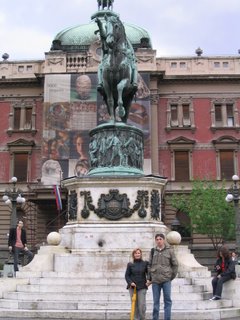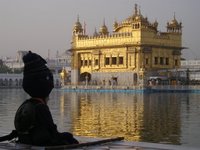I can say for sure I met some "people of the spirit" in Belgrade, Serbia and Montenegro. It started with my co-workers. As you all may know the strife and suffering caused by nationalistic corrupt leaders led to a brutal civil war and eventual break up of the former Yugoslavia (including NATO intervention). There was a time when the price of a cup of coffee would double in one day because of super inflation. The overall life systems were a mess. But now, the hard working younger educated generation have dreams and want to make things work. There is a silent technological and entrepreneurial revolutionary fervour among the masses. Well, this conference was organized by a friend of a collegue of mine who had emigrated during the recent war to North America (one to Canada and another to the US). Now that the political and economic climate is right, they are back and working on rebuilding their nation. I was just a small part of the speaking agenda and was simply promoting WLAN systems for enterprises and service providers.
The "people of the spirit" I met were essentially people on the street that said hi, were concerned and worried whether I was enjoying my time in Belgrade and just exhubed "hope". I was quite humbled. I had a memorable encounter with the shuttle driver from the hotel to the airport. He was 22 years old, just started working at the Hyatt as a shuttle driver and shared with me his aspirations to study Hospitality sciences and rise up the ranks in the hotel industry in Serbia. We talked about food, geography and dreams.
The Danube is the main river that cuts through Belgrade. Because of its location and the presence of the river, Belgrade (and Serbian region) has been subjected to wars, invasions and internal strife for centuries. My encounter with the people and very very brief encounter with their history (as told by the people) reminded me of the land where our Gurus laid their holy feet. Because of the strategic location of Panjab and its centuries of invasion, war and strife, the people of that area naturally transformed into "people of the spirit". And a common attribute among people who have been through such strife is "HOPE". The only difference between the Khalsa which was developed in Panjab and today is spread around the world, and the people of Belgrade is our "hope" is manifest and fulfilled within the context of the Grace of the Guru. I wonder what sustains their hope.
Anyway, I travel a lot for business. This was one of the first times that my business travel was transformed into a a spiritual reflection. I don't do that as often as I should. So - Thank you Belgrade!
Here are a few of pictures of Belgrade.
 My collegue and his wife.
My collegue and his wife. Famous war hero who fought for the independece of Serbia from the Ottoman Empire.
Famous war hero who fought for the independece of Serbia from the Ottoman Empire. We went for a stroll in a park on the banks of the Danube. The park is built within an ancient fort.
We went for a stroll in a park on the banks of the Danube. The park is built within an ancient fort. View of the Danube.
View of the Danube.



